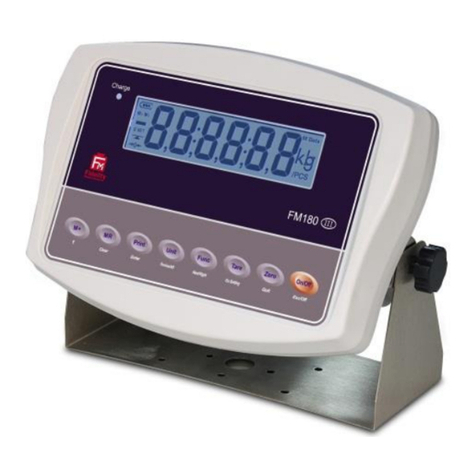Fidelity Electronics FM180S User manual

FM180S
STAINLESS STEEL WEIGHING INDICATOR
OPERATION MANUAL
PLEASE READ THIS MANUAL VERY CAREFULLY BEFORE
ATTEMPT TO OPERATE THIS INSTRUMENT
Specifications subject to change without prior notice
V100 Feb 2013

2

3
Content
1. Before Started........................................................................................... 6
1.1 Metrological Legislation...................................................................... 6
1.2 Seal & Serial Number. ........................................................................ 6
1.3 Warm up time ..................................................................................... 6
1.4 In case when in Doubt........................................................................ 6
2. Specifications............................................................................................ 7
3. Keys, Display & Connections.................................................................... 7
4. Getting Started........................................................................................ 12
4.1 Built-In Rechargeable Battery .......................................................... 12
4.2 Power Adaptor .................................................................................. 12
4.3 About DC Input Connector ............................................................... 12
4.4 About Blinder Covers........................................................................ 12
4.5 Connecting Other Devices ............................................................ 13
4.5.1 Connection with Weighing Platform or Load Cell Junction Box 13
4.5.2 Connecting RS232 To Computer .............................................. 13
4.5.3 Connecting RS232 to Printer (DB25)........................................ 14
5. Initial Setup ............................................................................................. 14
5.1 Internal Settings................................................................................ 14
5.2 How to Enter & Select Internal Function .......................................... 14
5.3 Key Function During Internal Function Mode................................... 15
5.4 Internal Function Table ..................................................................... 15
6. Instruction for Use................................................................................... 20
6.1 Power On.......................................................................................... 20
6.2 Start Weighing .................................................................................. 20
6.3 About Weigh Unit Conversion .......................................................... 20
6.3.1 Conversion between Metric Weight Units (kg and g)................ 20

4
6.3.2 Conversion between Metric (kg and/or g) & Imperial (lb) weight
units (F9) ............................................................................................ 21
6.4 Tare off the Weight of a Container.................................................... 21
6.4.1 Manual Tare .............................................................................. 21
6.4.2 Auto Tare (F12) ......................................................................... 21
6.4.3 Repeated Tare (F13) ................................................................. 22
6.4.4 Preset Tare (F63) ...................................................................... 22
6.5 Memory Accumulation Function ....................................................... 23
6.5.1 To Accumulate a Transaction to Memory .............................. 23
6.5.2 Memory Recall and Clearance.................................................. 23
6.6 Piece Count Function ....................................................................... 24
6.7 Sampling Process ............................................................................ 24
6.8 Shift among Quantity, Average Piece Weight and Weight Info ........ 25
6.9 To quit Piece Count Function ........................................................... 25
7. RS232 Data Output Mode ...................................................................... 26
7.1 Auto Weight Format String ............................................................. 26
8. Ticket / Receipt Printing .......................................................................... 27
8.1 Standard Print Output Format ........................................................ 27
8.1.1 Standard Output Print Format................................................... 27
8.1.1.2 Piece count function............................................................... 28
8.2 Custom Print Output Format ........................................................... 29
8.2.1 To Edit Custom Print Output Format ......................................... 29
8.2.2 Print Output Format Variants Table........................................... 30
8.2.3 Edit Sample for Custom Print Output Format ........................... 30
9. Label Printing (LP-50 or Compatible) ..................................................... 31
9.1 Label Format Groups & Label File Names....................................... 31
9.1.1 For 1 (Label Format Group 1) ................................................... 31

5
9.1.2 For 2 (Label Format Group 2) ................................................... 32
9.2 Label Programming .......................................................................... 32
9.2.1 Label Programing Information Table ......................................... 33
9.2.2 Label Programming Sample ..................................................... 33
10. Battery Power & Recharging ................................................................ 35
10.1 Symbols And Remaining Power: -.................................................. 35
10.2 Battery Operation Time .................................................................. 35
10.3 Recharge Battery ........................................................................... 35
11. Error Codes........................................................................................... 36
12. Daily Care & Maintenance .................................................................... 37
Appendix A: - Bi-Directional Communication Commands .......................... 38
Table of contents
Other Fidelity Electronics Accessories manuals


















